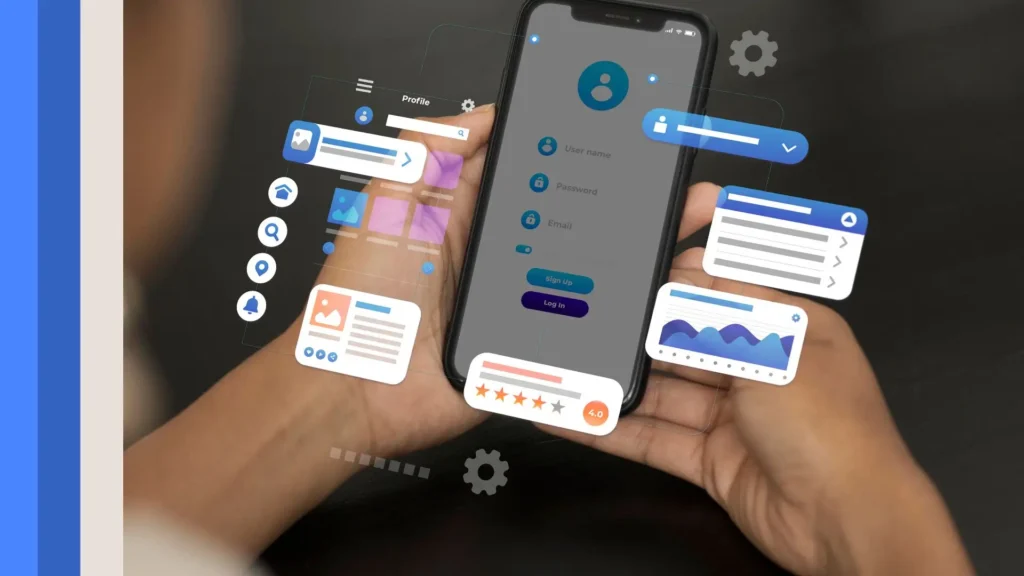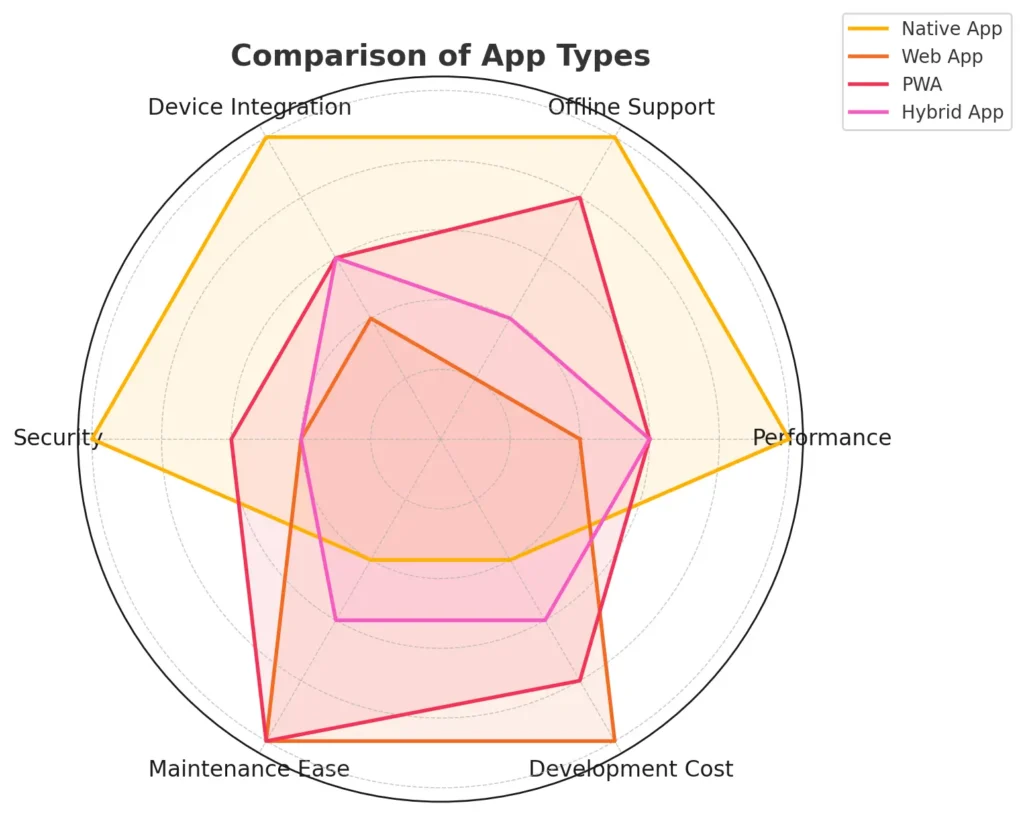An app designed for mobile devices is built to incorporate the special features, tools, and code created for the device’s operating system. As a result, the app benefits from all the device’s features and performs efficiently, giving the user a smooth experience.
Systems like the Apple App Store or Google Play are where most native mobile apps are distributed and where they are installed on your phone.
Most of the apps you get from the Apple Store or Google Play Store, as well as those that already exist on your phone, are native mobile apps. For many native apps, there is a web app too that you can run in your web browser.
Mobile apps made with native code vs. apps created using other types of code
Mobile devices can also run types of apps other than native ones
We are going to review how they differ from traditional web apps, progressive web apps, and wrapped or hybrid apps.
What’s the difference between native and web apps?
Like websites, traditional web apps are hosted inside a web browser. Unlike websites set up only to share information (like company and blog sites), web apps allow people to experience them in an interactive way (like SaaS tools or marketplaces). Unlike native apps, built-in web apps work on any platform, so you only need an up-to-date browser.

Ideally, your web apps should adjust to any screen size so that they look perfect no matter how small or large the screen. Content on Mirror is optimized no matter if you use it on your phone, a tablet, or your computer. You may accidentally miss a piece of information if you use web apps that are not responsive.
Since the servers for traditional web apps are located elsewhere, users can’t work on them without a web connection. As a result, how the network works, the server responds, and the browser’s capabilities can all impact the website’s performance. While traditional web apps may access the camera, microphone, or GPS, they usually can’t set push notifications or use Face ID.
Native mobile apps are different from progressive web applications (PWAs)
Progressive web apps have more advanced options than traditional web apps. PWAs do not require an installation, but you can still add them to the home screen for smooth and quick performance, even offline. Most web browsers allow you to install them, though some are also found in app stores.
Just as in the case of web apps, some organizations opt to release PWAs along with their native mobile apps. Spotify, for example, created a PWA that gives users lightweight features and an interface many users like. Even so, it misses some important functions found in the original mobile application, such as using it without an internet connection.
There are two types: native and wrapped or hybrid
Combining elements of web apps and native apps, wrapped or hybrid apps enable web apps to be accessible on a device.
While web apps are run directly by your browser, hybrid apps package a web app with a mini browser as its wrapper. Therefore, even though hybrid apps are not truly native, they function and appear like native mobile apps, so they can be downloaded and put in app stores. Native mobile apps may offer a better experience than web apps since they can lag when it comes to performance.
The words “wrapper” and “hybrid” refer to the same form of technology and are commonly used as if they were synonyms.
Benefits of native mobile apps
Integrating with the device they’re put on is an advantage native mobile apps have over the other types we’ve mentioned. We can observe how these advantages affect a few important elements.

Optimized performance
Mobile devices act as the middle point between web and hybrid apps, so their performance and efficiency may suffer. The reason for this is that web technologies like HTML, CSS, and JavaScript, either in a browser or a wrapper, help them function.
In another way, well-known mobile apps use languages that are particular to each operating system or else languages that work well on more than one kind of mobile device (such as React Native). Removing the web browser’s limitations allows web apps to run faster, and the apps can also connect directly with the phone’s central processor, graphics processing unit, and sensors. They can make the most of the platform by using its APIs and libraries.
Regular and the same quality of experience for users
The experience given by web apps can be significantly different from one to another. Some are straightforward, but some websites are hard to use and are associated with bad designs, and there is no common pattern for users to predict. This is because there is no generally accepted UX standard for web apps.
When designing native mobile apps, you have to use Apple’s HIG for iOS or Google’s Material Design for Android. Even though these rules permit great freedom in design, they help make every app in iOS feel similar to use. So, people can understand what happens and can use a consistent approach to navigate each app without learning something new.
Enhanced security
Security of a web app or hybrid app depends on the security of the browser or wrapper. In other words, if the browser has weaknesses or flaws, these can influence your web app too. This means web apps are often not reviewed for compliance with best practices, since they aren’t published in an app store.
Unlike hybrid apps, mobile apps only work on specific operating systems and must comply with special security guidelines to be allowed into the related app store. Natively installed apps can also depend on local encryption services such as Keychain on iOS and KeyStore on Android.

Offline functionality
While we rely on the internet all the time these days, people living or working in remote areas often can’t access it regularly. The majority of web and hybrid apps work online, so whenever your users lose internet access, they can’t access any part of your app.
When a person’s CRM app fails due to loss of cell or Wi-Fi, or their map app can’t direct them anymore, they may feel frustrated. However, native mobile apps store all necessary data on the connected device, which allows them to work even when there is no Internet access.
Apps made using native code and those created without coding
Generally, creating a native mobile application has been more difficult and costlier than creating web or hybrid apps. Thanks to Bubble’s updated features for native mobile apps, this is no longer an issue. We’ll see what challenges existed in making native mobile apps and understand how Bubble is addressing those issues.
Simplified development
Apps have generally used different frameworks for their web version and their mobile version since standard code and logic cannot be shared between them. For apps to work on iOS and Android, their codebase must be divided, with their development environments, sets of APIs, artistic languages, and hardware features.
With the use of frameworks like React Native, it has now become easier for developers to build apps for iOS and Android. As for the mobile part, the framework you’re using will build both Android and iOS from just one set of instructions. Consequently, you’ll create your app using visual interface elements and statements that are easy to understand.
On Bubble, both web apps, iOS apps, and Android apps can be made from a single database and using the same important processes. In addition, thanks to Bubble, you only need one tech tool when building a new mobile app.
Less work is required to keep the place in good shape
Developing codebases separately means you will need to manage each codebase, and both are certain to present different issues. Every user’s phone or tablet requires a separate installation for any app updates. Those who select automatic updates on their devices will get the new version within a short time, though it may take a little while to appear. If the users have to perform manual updates, they may fall behind and keep using old versions of your applications for a long period.
Since Bubble uses logic instead of complex code, it is much simpler to maintain. When you release an update, all the app’s different versions will receive it. You still require users to update their installed apps from time to time, but the web app is updated straight away after your updates are published.
Lower costs
Previously, creating an app for both platforms cost more than creating it for only one platform. A business can either use developers who know every detail of both platforms or set up teams, with each working only on one platform and collaborating with the other groups. Either way, it means tasks will double, and you need to be cautious to make sure both versions of the app are nearly identical and still follow every individual requirement for each platform.
Conclusion
Most businesses and developers turn to native mobile apps to ensure their mobile services are quick, dependable, and simple to use. “Even though it’s more expensive and demands additional time to build and uphold enterprise-level websites, they usually bring about greater customer satisfaction.” If you care about high-quality and active users of your app, you should consider creating a native app.





